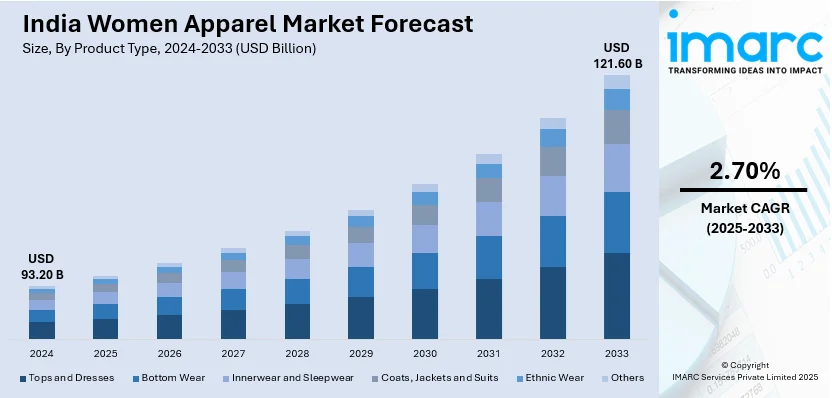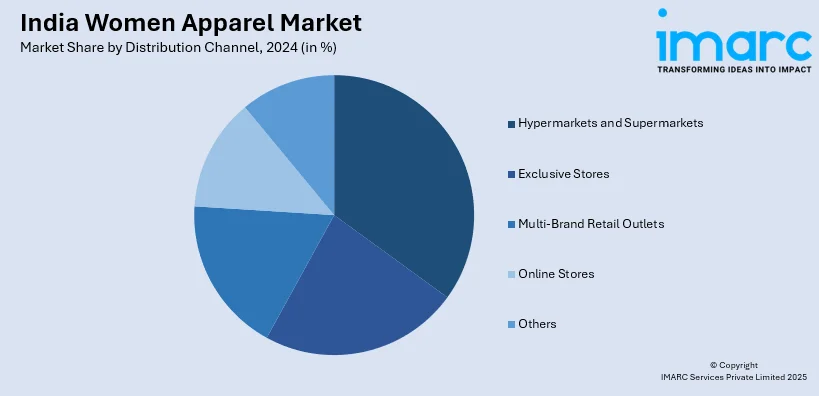
India Women Apparel Market Size, Share, Trends and Forecast by Product Type, Season, Distribution Channel, and Region, 2025-2033
India Women Apparel Market Overview:
The India women apparel market size reached USD 93.20 Billion in 2024. Looking forward, IMARC Group expects the market to reach USD 121.60 Billion by 2033, exhibiting a growth rate (CAGR) of 2.70% during 2025-2033. The market is driven by rising disposable income, evolving fashion trends, and growing e-commerce adoption. Moreover, the increasing sustainability awareness, expanding urbanization, rising influence of modern lifestyle and clothing preferences are some of the other factors providing a positive India women apparel market growth.
|
Report Attribute
|
Key Statistics
|
|---|---|
|
Base Year
|
2024 |
|
Forecast Years
|
2025-2033
|
|
Historical Years
|
2019-2024
|
| Market Size in 2024 | USD 93.20 Billion |
| Market Forecast in 2033 | USD 121.60 Billion |
| Market Growth Rate 2025-2033 | 2.70% |
India Women Apparel Market Trends:
Growth of E-commerce and Omni-channel Retailing
The expansion of e-commerce platforms like Myntra, Amazon, Flipkart, and brand-owned websites has made women’s apparel more accessible than ever. With easy returns, virtual try-ons, and recommendations tailored to individual tastes, online shopping provides convenience and variety. This digital shift is complemented by omni-channel retailing, where physical stores integrate with digital platforms to enhance the shopping experience. This model allows brands to cater to urban and rural customers alike, creating a positive India women apparel market outlook. The combination of online convenience and offline touchpoints is accelerating the overall growth of women’s fashion retail in India. For instance, in October 2024, NIYARA India, a high-end women's fashion label, opened its unique online store. Highlighting the importance of providing fashionable, stylish, and affordable clothing, the brand seeks to meet the increasing need for elegant yet budget-friendly attire for today's Indian women.

Rising Focus on Sustainable and Ethical Fashion
A growing number of Indian consumers, especially younger women, are becoming environmentally and socially conscious, driving demand for sustainable apparel. Brands are responding by offering clothing made from organic fabrics, using eco-friendly dyes, and promoting fair-trade practices. Consumers are increasingly choosing quality over quantity, favoring apparel that aligns with ethical production values. Initiatives such as upcycled fashion, rental clothing, and slow fashion are gaining traction and fueling the India women apparel market share. This focus on sustainability is reshaping consumer choices and also pushing traditional and new brands to innovate and commit to more responsible fashion practices. For instance, in March 2025, the Clothing Manufacturers Association of India (CMAI) introduced the SU.RE website along with the SU.RE Sustainable Supply Chain Directory, representing an important advancement in India’s sustainable fashion initiative. The platform acts as a thorough hub to support the Indian clothing sector's shift to sustainable methods, while the directory lists more than 600 validated suppliers in essential areas like fabric producers, recyclers, eco-friendly packaging specialists, and certifying organizations. These programs offer brands essential resources, encourage partnerships, and facilitate responsible sourcing effortlessly.
India Women Apparel Market Segmentation:
IMARC Group provides an analysis of the key trends in each segment of the market, along with forecasts at the regional level for 2025-2033. Our report has categorized the market based on product type, season, and distribution channel.
Product Type Insights:
- Tops and Dresses
- Bottom Wear
- Innerwear and Sleepwear
- Coats, Jackets and Suits
- Ethnic Wear
- Others
The report has provided a detailed breakup and analysis of the market based on the product type. This includes tops and dresses, bottom wear, innerwear and sleepwear, coats, jackets and suits, ethnic wear, and others.
Season Insights:
- Summer Wear
- Winter Wear
- All Season Wear
A detailed breakup and analysis of the market based on the season have also been provided in the report. This includes summer wear, winter wear, and all season wear.
Distribution Channel Insights:

- Hypermarkets and Supermarkets
- Exclusive Stores
- Multi-Brand Retail Outlets
- Online Stores
- Others
A detailed breakup and analysis of the market based on the distribution channel have also been provided in the report. This includes hypermarkets and supermarkets, exclusive stores, multi-brand retail outlets, online stores, and others.
Regional Insights:
- North India
- South India
- East India
- West India
The report has also provided a comprehensive analysis of all the major regional markets, which include North India, South India, East India, and West India.
Competitive Landscape:
The market research report has also provided a comprehensive analysis of the competitive landscape. Competitive analysis such as market structure, key player positioning, top winning strategies, competitive dashboard, and company evaluation quadrant has been covered in the report. Also, detailed profiles of all major companies have been provided.
India Women Apparel Market News:
- In September 2024, H&M announced its partnership with Anamika Khanna to launch a unique collection in India and selected international markets. At present, H&M has 64 outlets in 29 cities throughout India and plans to introduce this collection at 20 locations.
- In September 2024, Reliance Retail Ventures and Delta Galil announced their partnership to enhance the apparel market in India. The partnership will focus on creating an apparel innovation platform, leveraging Delta Galil's expertise in intimate and activewear while utilizing Reliance Retail's extensive distribution network.
India Women Apparel Market Report Coverage:
| Report Features | Details |
|---|---|
| Base Year of the Analysis | 2024 |
| Historical Period | 2019-2024 |
| Forecast Period | 2025-2033 |
| Units | Billion USD |
| Scope of the Report |
Exploration of Historical Trends and Market Outlook, Industry Catalysts and Challenges, Segment-Wise Historical and Future Market Assessment:
|
| Product Types Covered | Tops And Dresses, Bottom Wear, Innerwear And Sleepwear, Coats, Jackets And Suits, Ethnic Wear, Others |
| Seasons Covered | Summer Wear, Winter Wear, All Season Wear |
| Distribution Channels Covered | Hypermarkets and Supermarkets, Exclusive Stores, Multi-Brand Retail Outlets, Online Stores, Others |
| Regions Covered | North India, South India, East India, West India |
| Customization Scope | 10% Free Customization |
| Post-Sale Analyst Support | 10-12 Weeks |
| Delivery Format | PDF and Excel through Email (We can also provide the editable version of the report in PPT/Word format on special request) |
Key Questions Answered in This Report:
- How has the India women apparel market performed so far and how will it perform in the coming years?
- What is the breakup of the India women apparel market on the basis of product type?
- What is the breakup of the India women apparel market on the basis of season?
- What is the breakup of the India women apparel market on the basis of distribution channel?
- What is the breakup of the India women apparel market on the basis of region?
- What are the various stages in the value chain of the India women apparel market?
- What are the key driving factors and challenges in the India women apparel market?
- What is the structure of the India women apparel market and who are the key players?
- What is the degree of competition in the India women apparel market?
Key Benefits for Stakeholders:
- IMARC’s industry report offers a comprehensive quantitative analysis of various market segments, historical and current market trends, market forecasts, and dynamics of the India women apparel market from 2019-2033.
- The research report provides the latest information on the market drivers, challenges, and opportunities in the India women apparel market.
- Porter's five forces analysis assist stakeholders in assessing the impact of new entrants, competitive rivalry, supplier power, buyer power, and the threat of substitution. It helps stakeholders to analyze the level of competition within the India women apparel industry and its attractiveness.
- Competitive landscape allows stakeholders to understand their competitive environment and provides an insight into the current positions of key players in the market.
Need more help?
- Speak to our experienced analysts for insights on the current market scenarios.
- Include additional segments and countries to customize the report as per your requirement.
- Gain an unparalleled competitive advantage in your domain by understanding how to utilize the report and positively impacting your operations and revenue.
- For further assistance, please connect with our analysts.
 Inquire Before Buying
Inquire Before Buying
 Speak to an Analyst
Speak to an Analyst
 Request Brochure
Request Brochure
 Request Customization
Request Customization




.webp)




.webp)












